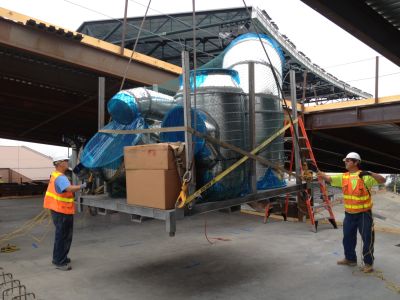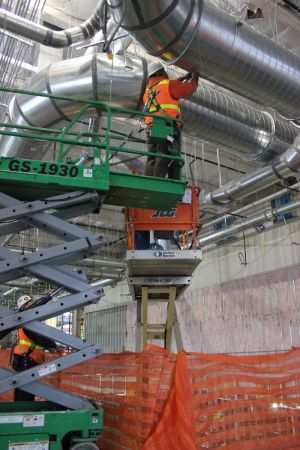
August 29, 2013
A Special Section of
DJC.COM
| Stories |
|
|
|
August 29, 2013 Stadium outfitted with 100 miles of pipes and duct
When the opportunity arises to discuss our involvement on the project, I find people are often surprised to learn that we designed and installed HVAC systems in what at first glance appears to be a simple open-air stadium. Well, if we stretched out all of the ductwork and piping that serves the new facilities in the stadium, it would surpass 100 miles! Obviously this 93-year-old icon is no longer just a stadium; it has transformed into a world-class athletic facility. The entire football program is now housed within the stadium, much of it requiring heating, cooling, dehumidification, and/or a variety of other processes necessary for the comfort, health and well-being of fans, staff and athletes. Multiple football-related facilities and services that were located or performed elsewhere on campus are now built into the complex, including a new 83,000-square-foot Football Operations Center. A new 30,000-square-foot Sports Medicine Center, run by UW Medicine, houses all related providers under one roof including state-of-the-art injury and rehabilitative services in the new Exercise Performance Center and Biomechanics Lab. Housed beneath the south stand seating and below grade, the center makes efficient and creative use of what otherwise would have been unused space. Also below the stadium seating is an expansive commercial kitchen that services concession stands throughout the stadium, as well as special events. The kitchen alone is 7,475 square feet and includes office space, storage, a walk-in cooler and a freezer. PSF designed and installed 11 grease exhaust systems for the kitchen and concession stands that serve the thousands of hungry sports fans in the stadium seats, plus many more in the Don James Center, private luxury suites, patio suites, Club Husky and Touchdown Terrace. The grease exhaust systems remove the cooking fumes, steam and oil particulates from the space. The heart of the HVAC system is the central plant, located at the parking garage level. The plant is comprised of two 280-ton air-cooled chillers, two heating water boilers, and the pumps, piping and other appurtenances required for a complete state-of-the-art system. The pump and boiler assemblies were prefabricated in the PSF pipe shop as part of our lean construction program and delivered to the job site on skids. When an assembly like this is prefabricated, installation time is reduced significantly and aids in accelerating the schedule.
Photo courtesy of PSF Mechanical Inc.
[enlarge]
Pre-assembled system
components and tools were put on skids and craned onto the floor.
All new construction projects in the city of Seattle are subject to stringent energy codes and the stadium renovation project was no different. Through hard work and creativity, the design team produced an HVAC system that is more energy efficient than required. For example, heat recovery units provide the weight-training facilities and visitor locker rooms with 100 percent outside air, and it is then all exhausted. Heat energy from exhausted air is being captured with heat recovery wheels. That heat is then used to pre-heat the outside air coming into the building, reducing the energy required to heat the space inside. Particular attention was paid to the well-being of the athletes during design of the HVAC systems, which are above and beyond systems used in similar facilities.
Photos courtesy of PSF Mechanical Inc.
[enlarge]
Scissor lifts were used to install ducts at the club level.
In addition to using 100 percent outside air, dehumidifiers expedite drying of equipment and uniforms, which in turn prevents the growth of molds and other undesirable organisms. One might suggest that this quite possibly gives the Huskies bragging rights to another first: the first stadium wave, the loudest stadium in the PAC 12, and now the freshest team facilities in the PAC 12. Another energy-saving feature is the re-purposing of heat, or heat recovery, in the hydrotherapy room at the Football Operations Center. The hydrotherapy room has two hot pools and one cold pool. The cold pool is cooled by a commercial aquarium cooler (yes, the same kind you might find at the Seattle Aquarium). The heat removed from the water to cool this pool is redistributed to the hot pools, reducing the energy required to heat them. This has been an exciting project. The size and scope of a project of this size and visibility requires the close communication and collaboration of a large number of highly skilled and talented individuals. Congratulations to all those involved including the students and athletes who will enjoy the benefits of this spectacular venue. Go Dawgs! Robert Willis, project executive with PSF Mechanical Inc., is a 38-year veteran of the commercial mechanical industry and was PSF's project team lead for the UW Husky Stadium renovation.
|


